International Relations: February 2024 UPSC Current Affairs | UPSC Mains: International Relations PDF Download
| Table of contents |

|
| India’s Act East Policy |

|
| Red Sea Disruptions and India’s Oil Import Dynamics |

|
| MEA’s Development Aid |

|
| Free Movement Regime |

|
| Economic Community of West African States |

|
India’s Act East Policy
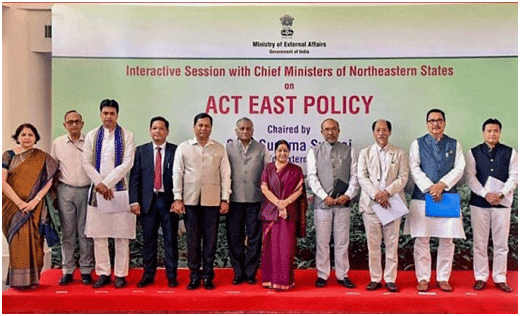
Context
Recently, the Ministry of Ports, Shipping and Waterways has initiated the first trial Cargo Vessels from Maia Inland Custom Port in West Bengal to Sultanganj Port in Bangladesh.
- This marks a significant stride under India’s Act East Policy, prioritizing the enhancement of Inland Water Transport. The initiative, spearheaded by the Inland Waterways Authority of India (IWAI), heralds improved connectivity and collaboration between India and Bangladesh.
Significance of Trial Shipment
The operationalization of Maia Terminal holds transformative potential, projected to divert 2.6 million tonnes per annum (MTPA) of Bangladesh-bound export cargo from roads to waterways. The Maia-Aricha route (Protocol Route 5 & 6) promises a reduction of 930 kilometers in distance from NW1 (National Waterways 1) to Bangladesh and the North Eastern Region.
Inland Water Transport (IWT)
About: IWT denotes the movement of goods and passengers via navigable rivers, canals, lakes, and other inland waterways, utilizing watercraft such as boats, barges, and ships. It serves as a cost-effective mode of transportation, especially for bulk cargo like coal, iron ore, cement, food grains, and fertilizers.
Significance: Despite its benefits, IWT comprises only 2% of India's modal mix. The government aims to elevate this share to 5% by 2030 through the Maritime India Vision (MIV)-2030, identifying 25 new National Waterways (NWs) for navigation.
Act East Policy
- About: Introduced in November 2014, the Act East Policy represents an upgrade of the preceding Look East Policy. It constitutes a diplomatic endeavor to bolster economic, strategic, and cultural ties with the expansive Asia-Pacific region, particularly Southeast Asian countries. The policy envisions proactive engagement across various sectors including connectivity, trade, culture, defense, and people-to-people contacts.
- Aim: The policy aims to foster economic cooperation, cultural exchange, and strategic partnerships with Indo-Pacific nations, focusing on enhancing the economic development of the North Eastern Region, serving as a gateway to Southeast Asia.
Look East Policy
- In response to the geopolitical shifts post the Cold War era, India launched the Look East Policy in 1992, aiming to strengthen ties with Southeast Asian nations and counterbalance the influence of China.
- It primarily focused on economic integration and strategic engagement with ASEAN countries.
Difference Between Look East Policy and Act East Policy
- Look East: Emphasized economic integration and engagement with ASEAN countries.
- Act East: Extends the focus to include East Asian countries and emphasizes security cooperation alongside economic integration. It underscores cultural exchange, commerce, connectivity, capacity building, and security, particularly in the context of China's assertiveness in the South China Sea and the Indian Ocean.
Initiatives to Enhance Connectivity under Act East Policy
- Agartala-Akhaura Rail Link
- Intermodal transport linkages and inland waterways through Bangladesh
- Kaladan Multimodal Transit Transport Project and Trilateral Highway Project
- India-Japan Act East Forum focusing on economic modernization of India’s North-East region
- Assistance to ASEAN countries during the pandemic, scholarships, Quick Impact Projects, and modal share enhancement strategies under Amrit Kaal Vision 2047.
Red Sea Disruptions and India’s Oil Import Dynamics
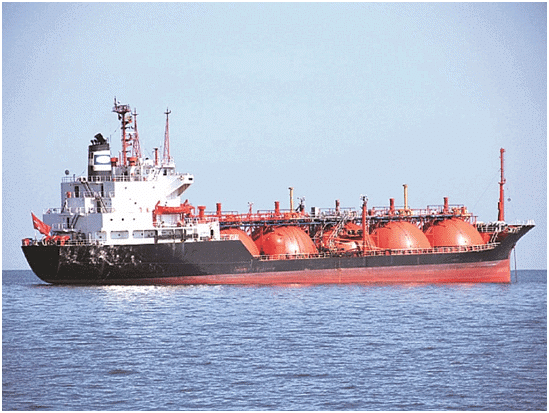
Context
The recent disturbances in the Red Sea have significantly impacted India's strategies regarding oil imports, prompting a shift away from conventional suppliers such as the US.
Reasons for India's Shift Away from US Oil Imports
India has traditionally counted the US among its top five crude oil suppliers, with an average procurement of 205,000 barrels per day (bpd) in 2023. However, recent data reveals a notable change, as Indian refiners refrained from acquiring any US crude in January 2024. This shift is attributed to the escalated freight rates caused by Red Sea disruptions, rendering US crude economically unfeasible for Indian refiners. Consequently, India has reverted to its traditional suppliers in the Persian Gulf region.
Incident in the Red Sea
A recent incident involving the chemical tanker MV Chem Pluto, which was struck by a drone attack approximately 200 nautical miles off Gujarat's coast, further underscores the challenges posed by the Red Sea unrest. The tanker, carrying crude from Saudi Arabia to India, fell victim to an attack believed to be orchestrated by Houthi rebels from Yemen, citing objections to Israel's actions in Gaza.
Top Crude-Oil Suppliers for India
- Russia: India's foremost oil supplier, with imports surging to 1.53 million bpd in January 2024, facilitated by discounted offers following Western sanctions on Russia due to the Russia-Ukraine Conflict.
- Iraq: The second-largest source of crude for India, with imports reaching 1.19 million bpd in January 2024, marking the highest since April 2022.
- Saudi Arabia: Maintaining its position as a key player in India's energy security landscape, Saudi Arabia exported approximately 690,172 bpd of crude oil to India in January 2024.
- UAE: Experiencing an 81% surge in oil imports in January 2024, reaching around 326,500 bpd, making Abu Dhabi India’s fourth-largest crude oil supplier.
Government Initiatives to Manage Surging Oil Demands
- Promoting Energy Efficiency: Schemes like PAT (Perform, Achieve and Trade) incentivize industries to reduce energy consumption, while star labeling for appliances aids consumers in choosing efficient options.
- Fuel Diversification: Initiatives such as the Ethanol Blending Program (EBP) aim to blend 20% ethanol with petrol by 2025, reducing gasoline dependence, alongside the promotion of Compressed Natural Gas (CNG) for vehicles.
- Electric Mobility: The FAME scheme subsidizes the electrification of public and shared transportation, with a target to achieve significant penetration of electric vehicles by 2030.
- Boosting Domestic Production: Attractive exploration policies, including Production Sharing Contracts (PSC) and technological advancements such as Enhanced Oil Recovery (EOR) techniques, aim to increase domestic oil and gas production.
Way Forward
- Diversifying Biofuel Development: Beyond ethanol blending, investing in advanced biofuels derived from various sources could reduce reliance on fossil fuels in transportation and industrial sectors.
- Promoting Sustainable Transportation: Enhancing public transportation systems and implementing green building standards can encourage sustainable modes of travel, reducing the demand for oil-based fuels.
- Towards a Hydrogen Economy: Developing India as a hydrogen economy presents a clean alternative to traditional fossil fuels, with applications in transportation, manufacturing, and power generation.
MEA’s Development Aid
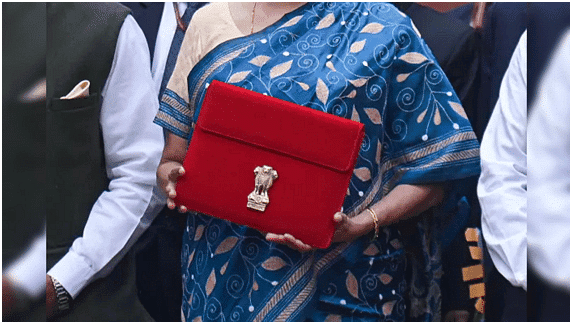
Context
In a recent announcement within the Interim Budget for the fiscal year 2024-25, the Ministry of External Affairs (MEA) has delineated its plans for development assistance, with a particular focus on strategic partnerships and neighboring nations.
- The MEA's aid initiatives are strategically designed to enhance and safeguard India's global influence and interests, in alignment with its foreign policy objectives. Moreover, these efforts aim to foster regional connectivity, cooperation, and stability through targeted developmental support.
Allocation of Development Aid Among Nations
- The ministry has earmarked a total of Rs 22,154 crore for the fiscal year 2024-25, a notable increase from the previous year's allocation of Rs 18,050 crore.
- Adhering to India's 'Neighbourhood First' policy, Bhutan emerges as the primary beneficiary, receiving the largest share of the aid portfolio with an allocation of Rs 2,068 crore. Other allocations include Rs 600 crore for the Maldives, Rs 200 crore for Afghanistan, Rs 120 crore for Bangladesh, Rs 700 crore for Nepal, Rs 75 crore for Sri Lanka, Rs 370 crore for Mauritius, Rs 250 crore for Myanmar, and a separate Rs 200 crore for various African nations.
- Additionally, Rs 4,883 crore has been allocated for development assistance to regions like Latin America and Eurasia, with a maintained allocation of Rs 100 crore for the Chabahar Port, underscoring India's emphasis on connectivity projects, particularly with Iran.
Other MEA Development Partnerships
- Beyond financial aid, the MEA extends humanitarian assistance during natural disasters, emergencies, and pandemics. India's extensive relief efforts during the Covid-19 pandemic, including the provision of medical supplies to over 150 countries, exemplify this commitment.
- Furthermore, the MEA fosters cultural and heritage cooperation through numerous projects across partner countries and prioritizes capacity building and technical assistance through initiatives like the Indian Technical and Economic Cooperation (ITEC) program. Moreover, India extends concessional Lines of Credit (LOCs) to support development projects in various sectors across partner nations.
Significance of Bhutan in India's Strategy
- Bhutan holds strategic importance for India as a buffer state between India and China. This strategic location bolsters India's security interests. India's commitment to Bhutan's socio-economic development, including substantial financial support and cooperation in sectors like hydro-power, underscores the depth of bilateral ties.
- The cooperation in hydro-power exemplifies the mutually beneficial nature of the relationship, providing Bhutan with revenue and employment opportunities while facilitating India's energy needs.
India's Neighbourhood First Policy
India's 'Neighbourhood First Policy' is pivotal in shaping its regional engagements, focusing on enhancing connectivity, trade, and people-to-people ties with neighboring nations. This policy underscores India's commitment to fostering stability and prosperity in the region.
Free Movement Regime
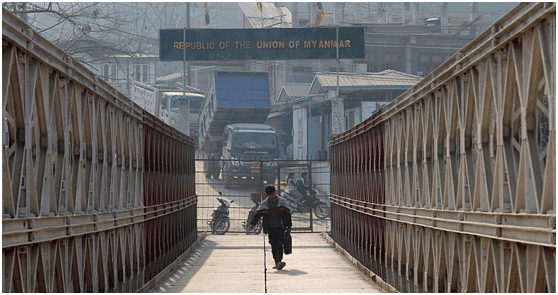
Context
India's recent announcement to reassess the Free Movement Regime (FMR) agreement with Myanmar and fortify the India-Myanmar border has sparked discussions, particularly in the northeastern states. This decision aims to address a complex interplay of historical, cultural, and security factors.
What is the Free Movement Regime?
- Historical Context: The Treaty of Yandaboo in 1826 delineated the current India-Myanmar boundary, ending the First Anglo-Burmese War. However, this border division separated communities with shared ethnicity and culture, such as the Nagas, Kuki-Chin-Mizo in Manipur and Mizoram, without their consent.
- Current Scenario: India and Myanmar share a 1,643 km border across Manipur, Mizoram, Nagaland, and Arunachal Pradesh, with only 10 km fenced in Manipur.
- FMR Establishment: Initiated in 2018 under India's Act East policy, the FMR permits cross-border movement up to 16 km without a visa. Border residents require a one-year border pass for short stays in the neighboring country, aiming to facilitate local trade, enhance access to education and healthcare, and strengthen diplomatic ties.
Potential Reasons for Reconsidering the FMR
- Security Concerns: Includes concerns over increased infiltration, drug trafficking, arms smuggling, and insurgency activities.
- Socio-economic and Regional Issues: Raises concerns about cultural preservation, environmental degradation, and regional dynamics, especially with China's growing influence in Myanmar.
Major Aspects of India-Myanmar Relations
- Historical and Cultural Ties: Rooted in centuries-old connections, underpinned by the Treaty of Friendship (1951).
- Economic Cooperation: India is a significant trading partner and investor in Myanmar, involved in various projects like the Kaladan Multimodal Transit Transport Project.
- Disaster Relief: India has been actively involved in providing assistance during natural calamities in Myanmar.
Way Forward
- Focus on Shared Interests: Emphasizes expanding economic cooperation and cultural exchanges to deepen ties.
- Comprehensive Border Management: Advocates for a balanced approach considering security concerns and legitimate cross-border activities.
- Supporting Democratic Transition: Stresses India's role in supporting Myanmar's transition to democracy for regional stability and prosperity.
Economic Community of West African States
Context
Recently, the military regimes in Burkina Faso, Mali and Niger announced their immediate withdrawal from the West African bloc Economic Community of West African States (ECOWAS).
What is ECOWAS?
- About: ECOWAS is a regional grouping aimed to promote economic integration and shared development of the West African sub-region.
- It was established in May 1975 by 15 West African countries in Lagos, Nigeria.
- Founding members: Benin, Burkina Faso, Côte d’Ivoire, The Gambia, Ghana, Guinea, Guinea Bissau, Liberia, Mali, Mauritania, Niger, Nigeria, Sierra Leone, Sénégal, and Togo.
- Headquarters: Abuja, Nigeria.
- Major Initiatives: ECOWAS established its free trade area in 1990 and adopted a common external tariff in January 2015.
- It has also worked to address some security issues by developing a peacekeeping force for conflicts in the region.
- Troops were initially sent to Liberia in 1990 during its civil war and to Sierra Leone in 1997 following the overthrow of a democratically elected government.
- India-ECOWAS Relation:
- India has a long-standing relationship with ECOWAS and was given the status of observer to the body in 2004.
- In 2006, India gave the grouping a line of credit (LoC) worth USD 250 million.
- ECOWAS has also supported India’s bid for a permanent seat in the United Nations Security Council.
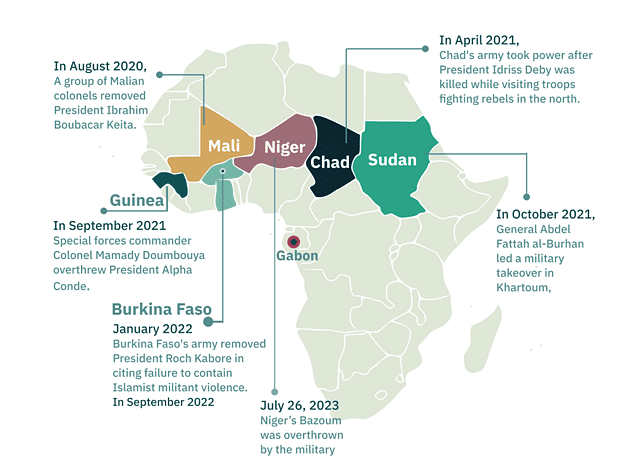
|
88 videos|124 docs
|
FAQs on International Relations: February 2024 UPSC Current Affairs - UPSC Mains: International Relations
| 1. What is India's Act East Policy and how does it impact its international relations? |  |
| 2. How do disruptions in the Red Sea affect India's oil import dynamics? |  |
| 3. How does the Ministry of External Affairs (MEA) contribute to development aid? |  |
| 4. What is the Free Movement Regime and how does it benefit participating countries? |  |
| 5. How does the Economic Community of West African States (ECOWAS) impact regional cooperation and economic development? |  |















